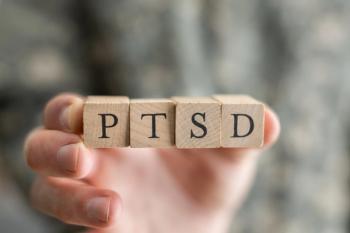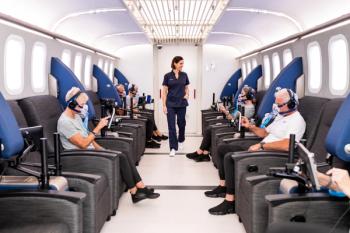
Virtual Reality for PTSD
Virtual reality (VR)-facilitated exposure therapy for posttraumatic stress disorder (PTSD), recently evaluated under combat conditions in Iraq, appears to be safe and effective, according to LCDR Robert McLay, research director for mental health with the US Naval Medical Center San Diego (NMCSD). Speaking at the 17th Annual Medicine Meets Virtual Reality (MMVR-17) Conference in Long Beach, Calif, McLay said that military providers need to make PTSD treatments available in such military theaters as Iraq and Afghanistan, as well as stateside. (McLay was speaking as an individual, not as a US Navy or Department of Defense representative.)
Virtual reality (VR)-facilitated exposure therapy for posttraumatic stress disorder (PTSD), recently evaluated under combat conditions in Iraq, appears to be safe and effective, according to LCDR Robert McLay, research director for mental health with the
Last year, a RAND Corporation research brief, “
Estimates are that PTSD develops in 11% to 17% of service members who have been deployed to combat zones and that the likelihood of symptoms increases for those with repeated deployments. While the “military is aggressive about providing mental health care at the front, how various treatments developed in civilian settings apply to care in a combat zone” is sometimes unclear, according to McLay and colleagues.1 VR is a “subset of exposure therapy.” It immerses patients in simulations of trauma-related environments in which the emotional intensity of the scenes can be precisely controlled by the clinician.
In 2005, the Office of Naval Research awarded $4 million to support tests of VR-based treatments at the NMCSD, the US Marine Corps Base and Naval Hospital at Camp Pendleton (Oceanside, Calif), and the Tripler Army Medical Center in Honolulu. McLay served as a principal investigator on the VR research protocols conducted at the NMCSD and the Naval Hospital at Camp Pendleton.
The VR system involves 3 computers. One displays the visual and auditory simulations developed by the
From February to September 2008, McLay served as a psychiatrist at Camp Fallujah, Iraq. “The base no longer exists, we handed it back to the Iraqis, but at the time, there were several thousand service members stationed there, and it was a center for medical treatment in al-Anbar Province.” At Camp Fallujah, McLay treated 175 patients, 11 of whom had combat-related PTSD, and 2 who had sexual assault–related PTSD. Treatment was conducted as part of routine clinical practice. Two modes of therapy were used: VR Exposure Therapy (VRET) and VR Graded Exposure Therapy (VRGET).
Six patients underwent VR treatment for PTSD; 5 of the patients had PTSD from previous deployments. One previously had been through an extensive course of therapy in the United States.
Patients received training in relaxation and biofeedback, recited their trauma narrative, were familiarized with the VR system, and then recited their trauma narrative while experiencing VR. Symptom changes were tracked by clinical interview and with the use of the PTSD Checklist–Military Version (PCL-M), the Patient Health Questionnaire, and the Beck Anxiety Inventory.
All patients showed some improvement with treatment, with a mean decrease in PTSD symptoms of 73% on the PCL-M. Five of the 6 patients showed effective remission of PTSD symptoms; the sixth was discharged before completing treatment.
Although the clinical experience involved relatively few patients, “it did show that VR can be successfully applied to treat PTSD in theater,” McLay noted. He cited examples of 2 patients.
A US Marine Corps sergeant began therapy during the sixth month of his 7-month deployment. This was the sergeant’s second combat deployment. PTSD had been diagnosed after his first deployment, and he had been taking Zoloft (sertraline) and Ativan (lorazepam) for a year and had received trauma-based focused therapy stateside. When the sergeant returned to Iraq, he still had significant PTSD (44 on the PCL-M) as well as moderate anxiety and depression. After 11 sessions of VR-assisted exposure therapy in 3 weeks, his PCL-M score dropped to 26, a 66% reduction in PTSD symptoms.
For another patient, a US Army medic who had been in Iraq “a couple of times,” McLay and his team could not identify the index trauma, so they used the more skills-based VRGET. The medic had moderate PTSD symptoms along with depression and anxiety. With treatment, his PCL-M score dropped from 46 to 23.
Stateside studies
In the United States, several clinical trials are under way to evaluate VR for treating PTSD. The University of Southern California’s Institute for Creative Technologies (ICT) in Los Angeles, in partnership with several military and research groups, developed a series of VR exposure environments (“Virtual Iraq”), which are designed to resemble the general contexts that most service members experience during deployment to Iraq. The scenarios are adjustable for time of day or night, weather changes, and other conditions. In addition to the visual and auditory stimuli presented in the VR head-mounted display, vibrotactile and olfactory stimuli can be delivered into the VR scenarios in real time by the clinician. The presentation of additive, combat-relevant stimuli in the VR scenarios is controlled via a separate “Wizard of Oz” control panel, while the clinician is in full audio contact with the patient. It enables the clinician to customize the therapy experience to the patient’s individual needs. The patient and clinician also can collaborate to come up with scenes that simulate the incident that led to the trauma.
“Virtual Iraq” is being implemented as an exposure therapy tool with active-duty service members and veterans at veterans, military, and university laboratory sites for VRET research and other PTSD-related investigations.
At the MMVR-17 conference, psychologist Albert Rizzo, PhD, a research scientist at the ICT and research professor in the department of psychiatry and the School of Gerontology at the University of Southern California, presented data on the efficacy of VRET.2,3 Study participants were active-duty service members (19 men, 1 woman; mean age, 28 years; age range, 21 to 51 years) who recently came back from Iraq and who had engaged in previous PTSD treatments (eg, group counseling, medication) without benefit. Results from the first 20 “Virtual Iraq” treatment completers indicate positive clinical outcomes with 16 no longer meeting diagnostic criteria for PTSD posttreatment and with only 1 not maintaining treatment gains at 3-month follow-up.
Also at the conference, Dennis Patrick Wood, PhD, a clinical psychologist at VRMC and a retired US Navy captain, reported on the effectiveness of using VRGET with physiological monitoring for treating combat-related PTSD in a pilot study and in a randomized study.4 VRGET, Wood said, trains patients to control their physical arousal and attentional focus in order to tolerate exposure to such cues as combat, gunfire, explosions, and helicopter/vehicle sounds.
A pilot study comprising 12 combat support personnel (ie, hospital corpsmen, Seabees, non-infantry Marines) found significant reductions in PTSD scores on the PCL-M and significant reductions in depression symptom severity. Wood also reported treatment outcomes for 9 military active-duty male volunteers who received a diagnosis of chronic PTSD and who completed the 10-week VRGET protocol as part of a randomized study. They, too, experienced reductions in the severity of their PTSD and depressive symptoms.
The VRMC’s VRGET system has been installed in 14 US Navy/Veterans Affairs hospitals and in 6 military hospitals operated by foreign governments, such as those in Poland and Croatia.
References:
References
1.
McLay RN, Johnston SL, Wiederhold M, Wiederhold BK. Use of virtual reality in Iraq to treat posttraumatic stress disorder. Presented at: 17th Annual Medicine Meets Virtual Reality Conference (Mental Health and Simulation Session); January 19, 2009; Long Beach, CA.
2.
Rizzo AA, Reger G, Gahm G, et al. Virtual reality exposure; therapy for combat related PTSD. In: Shiromani P, Keane, TM, LeDoux JE, eds.
Post-Traumatic Stress Disorder: Basic Science and Clinical Practice
. New York: Springer-Verlag; 2009.
3.
Rizzo AA, Difede J, Rothbaum BO, et al. VR PTSD exposure therapy results with active duty OIF/OEF combatants. In: Westwood JD, Westwood SW, Haluck RS, et al, eds.
Medicine Meets Virtual Reality 17, Studies in Health Technology and Informatics.
Amsterdam: IOS Press; 2009:277-282.
4.
Wood DP, Murphy JA, Center KB, et al. Effectiveness of virtual reality graded exposure therapy with physiological monitoring for combat-related post traumatic stress disorder. Presented at: 17th Annual Medicine Meets Virtual Reality Conference (Mental Health and Simulation Session); January 19, 2009; Long Beach, CA.
Newsletter
Receive trusted psychiatric news, expert analysis, and clinical insights — subscribe today to support your practice and your patients.













